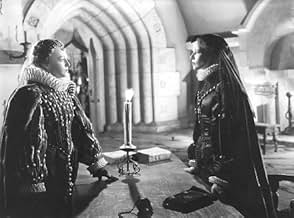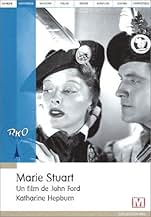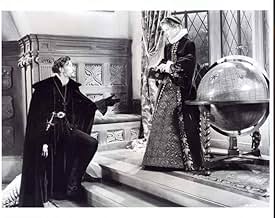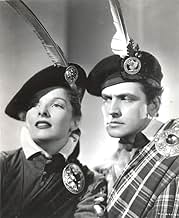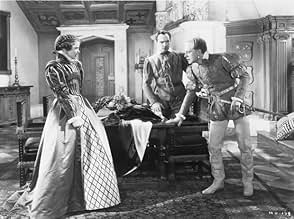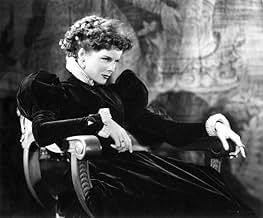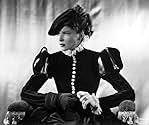CALIFICACIÓN DE IMDb
6.3/10
2.9 k
TU CALIFICACIÓN
La recientemente viuda Mary Stuart regresa a Escocia para reclamar su trono, pero se opone a su medio hermano y sus propios señores escoceses.La recientemente viuda Mary Stuart regresa a Escocia para reclamar su trono, pero se opone a su medio hermano y sus propios señores escoceses.La recientemente viuda Mary Stuart regresa a Escocia para reclamar su trono, pero se opone a su medio hermano y sus propios señores escoceses.
- Dirección
- Guionistas
- Elenco
- Premios
- 3 premios ganados y 1 nominación en total
- Dirección
- Guionistas
- Todo el elenco y el equipo
- Producción, taquilla y más en IMDbPro
Opiniones destacadas
The directors cannot refrain from showing the two queens together in one scene.Charles Jarrot -whose movie is inferior to John Ford's- did the same in 1972.And however,they never met ,not a single time during Mary's captivity.But John Ford's scene is useful for people who know little about the Virgin Queen.It's sure that Mary's childhood in France was a nice one even though her reign was short as king François II's wife.On the other hand,Elizabeth lived in fear when she was a child for her bloody sister wanted to get rid of her.
The first past begins in Scotland ,and France is only evoked in Mary's memories.This first part is the most satisfying historically speaking:Darnley's and Ricci's murders are well directed by Ford,and the town criers who ,every ten minutes announce "It's eight'o clock!All is fine!" shows his sense of humor.Biggest flaw is the little part of James Stuart, aka"the bastard" aka Maurey:This man is really the stringman,who plays a prominent part in the queen's downfall,holding Mary like a puppet on a string,travelling to France when rebellion begins -he was not here when Mary was imprisoned in Lochleven-,just coming back to reap the benefits (regency he had lost when his sister came back).
Frederic March is a fine actor,but his Bothwell is not credible.Bothwell was a hairy brute ,not the romantic chivalrous fair knight we see here.Mary's abduction remains a mysterious part because the historians have no documents of what really happened.Mary's captivity in Lochleven-where she at last understood how James Stuart fooled her -and her extraordinary escape -worthy of Hitchcock's suspense-lasts barely 30 seconds on the screen.
Ditto for Mary's captivity in England.When she arrived,she was in what we would call "under house arrest" today.Only during her last year,when they discovered a plot,she was taken to the fortress of Fotheringay (a wonderful Fairport Convention song by the way),she was really a prisoner in the modern sense of the term.And she had a whole floor for herself though.
The trial is unsatisfying.At the time,Mary did not care for Bothwell anymore,she was longing to become a martyr of the Catholic cause.She did not know that the pope did not take her seriously .The scene with Donald is pure romantic fiction.
All in all ,and even if the things fall apart a bit in the second part,the movie is magnificently enhanced by Hepburn's presence and Ford -they said they had a love affair on the set- lovingly films her.I've been told that the scene between Bothwell and the queen on the tower was filmed by KH herself.
The first past begins in Scotland ,and France is only evoked in Mary's memories.This first part is the most satisfying historically speaking:Darnley's and Ricci's murders are well directed by Ford,and the town criers who ,every ten minutes announce "It's eight'o clock!All is fine!" shows his sense of humor.Biggest flaw is the little part of James Stuart, aka"the bastard" aka Maurey:This man is really the stringman,who plays a prominent part in the queen's downfall,holding Mary like a puppet on a string,travelling to France when rebellion begins -he was not here when Mary was imprisoned in Lochleven-,just coming back to reap the benefits (regency he had lost when his sister came back).
Frederic March is a fine actor,but his Bothwell is not credible.Bothwell was a hairy brute ,not the romantic chivalrous fair knight we see here.Mary's abduction remains a mysterious part because the historians have no documents of what really happened.Mary's captivity in Lochleven-where she at last understood how James Stuart fooled her -and her extraordinary escape -worthy of Hitchcock's suspense-lasts barely 30 seconds on the screen.
Ditto for Mary's captivity in England.When she arrived,she was in what we would call "under house arrest" today.Only during her last year,when they discovered a plot,she was taken to the fortress of Fotheringay (a wonderful Fairport Convention song by the way),she was really a prisoner in the modern sense of the term.And she had a whole floor for herself though.
The trial is unsatisfying.At the time,Mary did not care for Bothwell anymore,she was longing to become a martyr of the Catholic cause.She did not know that the pope did not take her seriously .The scene with Donald is pure romantic fiction.
All in all ,and even if the things fall apart a bit in the second part,the movie is magnificently enhanced by Hepburn's presence and Ford -they said they had a love affair on the set- lovingly films her.I've been told that the scene between Bothwell and the queen on the tower was filmed by KH herself.
Brooks Atkinson was a first rate drama critic for the New York Times. He had blind spots. He over enthused on the career of Maxwell Anderson. Anderson wrote some good plays such as "Winterset", but Anderson was enthusiastic of Anderson's pompous attempts to do dramas in blank verse: "Mary Of Scotland", "Elizabeth The Queen", and "Anne Of The Thousand Days".
The problem with these plays is, even if they get the history right they are too stiff. Compare the conclusion of "Elizabeth The Queen" to "A Man For All Seasons". Yes, the loneliness of the elderly Elizabeth is shown as Essex goes to his doom - but in reality Elizabeth knew there were other young men to replace her dangerous, ambitious lover. In "All Seasons" the tragedy of a rotten system crushing the life of a decent, thoughtful man like Thomas More is far more powerful as it's stark tragedy is silently brought to us.
That said, the first of the three Tudor tragedies to be filmed was "Mary Of Scotland". It is above average because it is starring Katherine Hepburn (a distant relative of Mary's third husband the Earl of Bothwell) and Frederic March, and directed wholly or partially by John Ford. It suffers from being black and white, except for one moment of sheer unexpected terror: when Mary sees the Scots nobles who oppose her they are photographed in such light and darkness to look like ogres in a nightmare.
The film follows the reign of Mary from 1560 to her execution in 1587. Most Americans do not understand the great difficulties that Mary (and Elizabeth) both faced in their parallel reigns. While England and Scotland allowed for female monarchs, women were not considered good material for rulers. They were considered governed by their emotions more than by their brains. Those women who ruled well were usually married to capable partners (Isabella of Castille and Ferdinand of Aragon of Spain). More frequently they were dismissed as misfits, like Isabella and Ferdinand's daughter Juana the Mad).
Mary had other problems. From 1400 to 1560 the nobles of Scotland got a great boon. Scotland had a series of minors who grew up to be king, married, and then died before they could cement their monarchic views on the government. The nobles cemented their local powers at the expense of a weak central authority.
Mary had been Queen of France, married to Francis II who ruled for a two year period (1559 - 1560). As Mary was the niece of the Duc De Guise, the king's power-hungry mother Catherine De Medici hated her. When Francis died suddenly, Catherine encouraged Mary to return to rule her own country. Surprised Mary did so, not realizing that she was unprepared to start ruling. She was a Catholic, and she really needed some time to understand the need to compromise and take advice from Protestants. She never did understand this.
Her foes hated her and were fully supported by Elizabeth, who never could see that an attempt to join forces with her cousin might pay back great dividends. But then Mary was ambitious - she wanted to be Queen of England as well as Scotland. Her Catholic supporters felt she was legitimate Queen of England (as Henry VIII had briefly disowned Elizabeth as a bastard when he executed her mother Anne). So the peaceful resolution of their differences was almost impossible.
Elizabeth had only to watch from the sidelines, with only an occasional move on her own part, to see Mary wreck her own position. She encouraged a marriage between another cousin/potential heir Lord Henry Darnley to Mary (Mary almost chose Elizabeth's lover Robert Dudley!). The marriage was a disaster, as Darnley was an ambitious fool and vicious scoundrel. But it cemented a Scottish succession to the British throne from two Tudor heirs instead of one.
Hepburn portrays Mary as a brave woman desperately seeking a way out of the difficult situation she has inherited, especially tied to Darnley by marriage and facing the ghouls who are John Knox (Moroni Olsen) and the Scottish nobles - led by her jealous half brother the Earl of Moray (Ian Keith). Her only allies are the independent Earl of Bothwell (March) and her secretary Rizzio (John Carridine). The murder of the latter (implicating Darnley) is the first step to her loss of the throne, and to the death of her husband. We know today that Kirk'a'Field house was blown up by Bothwell, but to this day we don't know if Mary was implicated. It remains one of the big mysteries of the 16th Century.
Historically Bothwell was no prince, but ambitious in his own right - he killed Darnley in order to marry Mary, and guide her to rule both Scotland and England. But March plays him as a man deeply in love with his Queen, and this enhances the story's tragedy - especially as Bothwell died in exile insane. The reason for this was his ship was captured by a Danish warship. Bothwell was guilty of a rape in Denmark, and was imprisoned. His punishment (which led to his madness) was to stand chained to a stone pillar that was half his height.
The last ten minutes glosses over the road that led Mary to the block in England - her support of a plot by one Anthony Babbington to kill Elizabeth and let Mary take the throne. Elizabeth's spy-master Sir Francis Walsingham sprung this trap - though Elizabeth did not reject the result. Elizabeth allowed a functionary to be blamed for falsely getting her to sign the death warrant - but all she did was briefly imprison the man. Unlike her movie representative (Florence Eldritch) she never met Mary.
A good film - but it is too gentle on Mary's failings, and not deep enough to explain what is going on in the background.
The problem with these plays is, even if they get the history right they are too stiff. Compare the conclusion of "Elizabeth The Queen" to "A Man For All Seasons". Yes, the loneliness of the elderly Elizabeth is shown as Essex goes to his doom - but in reality Elizabeth knew there were other young men to replace her dangerous, ambitious lover. In "All Seasons" the tragedy of a rotten system crushing the life of a decent, thoughtful man like Thomas More is far more powerful as it's stark tragedy is silently brought to us.
That said, the first of the three Tudor tragedies to be filmed was "Mary Of Scotland". It is above average because it is starring Katherine Hepburn (a distant relative of Mary's third husband the Earl of Bothwell) and Frederic March, and directed wholly or partially by John Ford. It suffers from being black and white, except for one moment of sheer unexpected terror: when Mary sees the Scots nobles who oppose her they are photographed in such light and darkness to look like ogres in a nightmare.
The film follows the reign of Mary from 1560 to her execution in 1587. Most Americans do not understand the great difficulties that Mary (and Elizabeth) both faced in their parallel reigns. While England and Scotland allowed for female monarchs, women were not considered good material for rulers. They were considered governed by their emotions more than by their brains. Those women who ruled well were usually married to capable partners (Isabella of Castille and Ferdinand of Aragon of Spain). More frequently they were dismissed as misfits, like Isabella and Ferdinand's daughter Juana the Mad).
Mary had other problems. From 1400 to 1560 the nobles of Scotland got a great boon. Scotland had a series of minors who grew up to be king, married, and then died before they could cement their monarchic views on the government. The nobles cemented their local powers at the expense of a weak central authority.
Mary had been Queen of France, married to Francis II who ruled for a two year period (1559 - 1560). As Mary was the niece of the Duc De Guise, the king's power-hungry mother Catherine De Medici hated her. When Francis died suddenly, Catherine encouraged Mary to return to rule her own country. Surprised Mary did so, not realizing that she was unprepared to start ruling. She was a Catholic, and she really needed some time to understand the need to compromise and take advice from Protestants. She never did understand this.
Her foes hated her and were fully supported by Elizabeth, who never could see that an attempt to join forces with her cousin might pay back great dividends. But then Mary was ambitious - she wanted to be Queen of England as well as Scotland. Her Catholic supporters felt she was legitimate Queen of England (as Henry VIII had briefly disowned Elizabeth as a bastard when he executed her mother Anne). So the peaceful resolution of their differences was almost impossible.
Elizabeth had only to watch from the sidelines, with only an occasional move on her own part, to see Mary wreck her own position. She encouraged a marriage between another cousin/potential heir Lord Henry Darnley to Mary (Mary almost chose Elizabeth's lover Robert Dudley!). The marriage was a disaster, as Darnley was an ambitious fool and vicious scoundrel. But it cemented a Scottish succession to the British throne from two Tudor heirs instead of one.
Hepburn portrays Mary as a brave woman desperately seeking a way out of the difficult situation she has inherited, especially tied to Darnley by marriage and facing the ghouls who are John Knox (Moroni Olsen) and the Scottish nobles - led by her jealous half brother the Earl of Moray (Ian Keith). Her only allies are the independent Earl of Bothwell (March) and her secretary Rizzio (John Carridine). The murder of the latter (implicating Darnley) is the first step to her loss of the throne, and to the death of her husband. We know today that Kirk'a'Field house was blown up by Bothwell, but to this day we don't know if Mary was implicated. It remains one of the big mysteries of the 16th Century.
Historically Bothwell was no prince, but ambitious in his own right - he killed Darnley in order to marry Mary, and guide her to rule both Scotland and England. But March plays him as a man deeply in love with his Queen, and this enhances the story's tragedy - especially as Bothwell died in exile insane. The reason for this was his ship was captured by a Danish warship. Bothwell was guilty of a rape in Denmark, and was imprisoned. His punishment (which led to his madness) was to stand chained to a stone pillar that was half his height.
The last ten minutes glosses over the road that led Mary to the block in England - her support of a plot by one Anthony Babbington to kill Elizabeth and let Mary take the throne. Elizabeth's spy-master Sir Francis Walsingham sprung this trap - though Elizabeth did not reject the result. Elizabeth allowed a functionary to be blamed for falsely getting her to sign the death warrant - but all she did was briefly imprison the man. Unlike her movie representative (Florence Eldritch) she never met Mary.
A good film - but it is too gentle on Mary's failings, and not deep enough to explain what is going on in the background.
This is a good costume-designing , historic-drama and Katherine Hepburn is well cast in the title role . She plays a tragic , romantic heroine that contends with various treacheries . Mary (1516-1558) inherited the throne of Scotland from Jacob V . She was next in line to the English kingdom , and married Francisco II , king of France , but he died early . Having been in France for thirteen years , Mary returned Scotland , and arrives from France with some misgivings . Then , Mary disembarks in Leith and goes to a castle near Edimburg , along with David Rizzio (a cadaverous John Carradine) , court musician and confidant . There , she's received by his brother , the Earl James Stuart , (Ian Keith) . Later on , Queen Mary married a foppish named Lord Darnley (Walton) . But Mary falls in love with Bothwell (a stylish Fredric March) , a kilted Earl and her supporter in her battle for power . Then , Rizzio was reputed to be the father of Mary's , the future James I of England . Darnley , with some underlings , murdered Rizzio in Mary's presence . But Darnley is killed by an explosion in his refuge , outskirts Edimburg , and the God-fearing Calvinists led by John Knox (Moroni Olsen who played same role in stage) accused to Bothwell as regicide . John Knox and the rebels Lords besiege Holyrood and the Borthwell's stronghold , Dumbar castle . The Calvinists forced her abdication , Mary escapes and asks for protection to Queen Elizabeth I (Florence Eldridge) , but Mary is double-crossed and is taken imprisoned in the Tower of London . Although supposedly Mary and Elizabeth never met face to face , the movie have them doing so and the screen crackle when both have their reunion , because they are strong rivals for power in Tudor dynasty , England . After that , Mary confronts her English accusers at court in a stylized trial . Finally , the film reflects splendidly when Mary goes to beheading block with all due pomp and circumstance .
The motion picture is finely performed by Katharine Hepburn, in spite of this she was in her ¨box-office poison¨ days , the last scenes , where Mary confronts trial is so well played and photographed in a stylized manner -with Mary on the floor and judges in a sort of balcony- by cameraman Joseph August . However , the picture is interminable and overlong and some moments is frankly boring . Writing credits with excessive speeches by Maxwell Anderson (his own playwright) and Dudley Nichols , a Ford's habitual screenwriter . The picture is lavishly produced by Pandro S. Berman , an usual costumer's producer and professionally directed by John Ford . Followed by a remake with the same title (1971) with Vanessa Redgrave as Mary and Glenda Jackson as Elizabeth and directed by Charles Jarrott .
The motion picture is finely performed by Katharine Hepburn, in spite of this she was in her ¨box-office poison¨ days , the last scenes , where Mary confronts trial is so well played and photographed in a stylized manner -with Mary on the floor and judges in a sort of balcony- by cameraman Joseph August . However , the picture is interminable and overlong and some moments is frankly boring . Writing credits with excessive speeches by Maxwell Anderson (his own playwright) and Dudley Nichols , a Ford's habitual screenwriter . The picture is lavishly produced by Pandro S. Berman , an usual costumer's producer and professionally directed by John Ford . Followed by a remake with the same title (1971) with Vanessa Redgrave as Mary and Glenda Jackson as Elizabeth and directed by Charles Jarrott .
Katharine Hepburn plays the young queen in this John Ford version of the rivalry between Mary of Scots and her cousin, Elizabeth I (played by Florence Eldridge; whose husband Fredric March plays a jaunty Lord Bothwell). Cut back to the bare bones, and squarely on the differences between the two women, it isn't altogether successful.
John Knox rants his Protestant spiel, Bothwell appears with a retinue of pipers (at several points); Darnley's murder is glossed over, as is his smallpox. John Carradine has a well-defined role as the ill-fated David Rizzio, while Mary's parasitical court of Lords are quirkily represented and dismissed.
Hepburn isn't as bad as one would fear, but it wasn't really a suitable role for her, nor, one would expect, was the material enough for tough director Ford to make much of. So this film remains a misfire, with some interesting sequences and some strong performances, but as a whole, it just doesn't work.
John Knox rants his Protestant spiel, Bothwell appears with a retinue of pipers (at several points); Darnley's murder is glossed over, as is his smallpox. John Carradine has a well-defined role as the ill-fated David Rizzio, while Mary's parasitical court of Lords are quirkily represented and dismissed.
Hepburn isn't as bad as one would fear, but it wasn't really a suitable role for her, nor, one would expect, was the material enough for tough director Ford to make much of. So this film remains a misfire, with some interesting sequences and some strong performances, but as a whole, it just doesn't work.
The life story of Mary, Queen of Scots is a thoroughly engaging one. I recommend anyone who wants to know more about the history while being entertained at the same time to check out the two Jean Plaidy books, ROYAL ROAD TO FOTHERINGAY and its sequel, THE CAPTIVE QUEEN OF SCOTS - two great little novels that tell you all there is to know.
MARY OF Scotland is an all-too Hollywoodised version of the story that suffers from an exceptionally overlong running time, unfortunately. It's strange, because some parts of the production are exceptionally slow and boring, while 19 years of history is condensed into about five minutes. There are a few eventful bits but for the most part this is a drag.
The director is none other than John Ford, but despite the presence of such a cinematic luminary, he seems uninterested in the material which is lifeless as a result. Katharine Hepburn is also a disappointment as Mary herself, singularly failing to make the queen sympathetic in any way. Fredric March does what he can as Bothwell, and there are nice little roles for John Carradine and Moroni Olsen, but it's not enough.
I particularly disliked the way that some good little bits of history are omitted or simplified for no apparent reason. For instance, Douglas Walton's final scene didn't happen that way at all and much more drama could have been made of it. Instead all the focus is on the talk and its incessant and goes nowhere. The definitive story of Mary, Queen of Scots this certainly isn't.
MARY OF Scotland is an all-too Hollywoodised version of the story that suffers from an exceptionally overlong running time, unfortunately. It's strange, because some parts of the production are exceptionally slow and boring, while 19 years of history is condensed into about five minutes. There are a few eventful bits but for the most part this is a drag.
The director is none other than John Ford, but despite the presence of such a cinematic luminary, he seems uninterested in the material which is lifeless as a result. Katharine Hepburn is also a disappointment as Mary herself, singularly failing to make the queen sympathetic in any way. Fredric March does what he can as Bothwell, and there are nice little roles for John Carradine and Moroni Olsen, but it's not enough.
I particularly disliked the way that some good little bits of history are omitted or simplified for no apparent reason. For instance, Douglas Walton's final scene didn't happen that way at all and much more drama could have been made of it. Instead all the focus is on the talk and its incessant and goes nowhere. The definitive story of Mary, Queen of Scots this certainly isn't.
¿Sabías que…?
- TriviaKatharine Hepburn credited John Ford with saving her life one day on the set. They were shooting a scene of Hepburn on horseback when the horse she was riding kept going unexpectedly. Ford yelled at Hepburn to duck just before she was about to collide with a low branch.
- ErroresMary's execution takes place outdoors. It actually took place in the great hall of Fotheringay Castle.
- Citas
Mary, Queen of Scots: [to Queen Elizabeth I] I might have known you'd come to gloat like this - stealthily, under cover of night.
- Créditos curiososOpening credits: "Like two fateful stars, Mary Stuart and Elizabeth Tudor appeared in the sixteenth century, to reign over two great nations in the making ... They were doomed to a life-and-death struggle for supremacy, a lurid struggle that still shines across the pages of history ... But today, after more than three centuries, they sleep side by side, at peace, in Westminster Abbey."
ENGLAND
- Versiones alternativasExists in a computer-colorized version.
- ConexionesFeatured in The Costume Designer (1950)
Selecciones populares
Inicia sesión para calificar y agrega a la lista de videos para obtener recomendaciones personalizadas
Detalles
- Fecha de lanzamiento
- País de origen
- Idioma
- También se conoce como
- Mary of Scotland
- Locaciones de filmación
- Productora
- Ver más créditos de la compañía en IMDbPro
- Tiempo de ejecución2 horas 3 minutos
- Color
- Relación de aspecto
- 1.37 : 1
Contribuir a esta página
Sugiere una edición o agrega el contenido que falta


